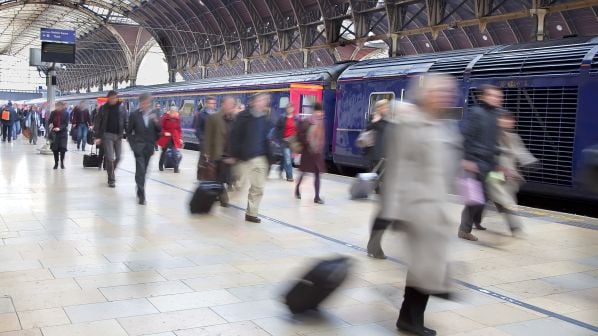FOUR years have passed since the International Association of Public Transport’s (UITP) last Global Public Transport Summit in Stockholm. IRJ’s coverage in the run-up to that event centred around several key themes: combating urban congestion and pollution by shifting more people to electrified mass transit; finding the funds to build new infrastructure; speeding up delivery of these key projects; improving integration between different modes of transport; boosting capacity; and effective delivery of digitalisation.
As the global public transport community finally gathers for this month’s summit in Barcelona, these challenges remain but within a whole new context.
The Covid-19 pandemic has changed the paradigm for public transport in cities around the world. Ridership dwindled to almost nothing in March 2020, forcing governments to step in with unprecedented financial support to keep services running.
Operators are continuing to claw passengers back with some now beginning to exceed their 2019 ridership levels: Barcelona Metropolitan Transport (TMB), for example, reported carrying a record 1.53 million passengers on its metro network on April 27, a single day record. It also carried 4% more passengers in January to April 2023 than in the same period in 2019, its previous record high.
This is not the same story everywhere. The rise of teleworking means that for many, the five-day commute is a thing of the past. Operators are consequently adjusting to a flatter peak as greater flexibility at work sees people coming into the office at different times on two or three days a week.
Concurrently, weekend traffic has roared back, and in many more cases now exceeds pre-pandemic levels. After being cooped up at home for most of the week, more and more people are seemingly choosing to head into town on Saturdays and Sundays for leisure.
Operators need to and are adapting to this phenomenon. They are adopting new fare structures to offer greater flexibility to previous five-day-a-week commuters. Regional operators are also rebranding services and creating new offers centred on leisure.
The rise of teleworking means that for many, the five-day commute is a thing of the past.
Milan Transport (ATM) is one operator that used the pandemic as an opportunity to rethink its offer and wider business model. Ridership is slowly increasing but remains 15-20% below what it was pre-pandemic. ATM recognised that it needs to find efficiencies and new revenue streams. It has since doubled down on digitalisation, especially to inform maintenance practices, introduce contactless ticketing for passengers, and pursued the wider rollout of ATO. ATM has also changed its non-fare revenue business, including by improving its offer to advertisers.
ATM hopes its positive experience will help it to win operations and consultancy contracts outside of Milan, another new way of generating revenue, which we will reflect on in our September issue.
When ATM does win this work, it will adapt to specific market circumstances as well as other macroeconomic challenges. The Covid pandemic after all was not the only crisis of the past three years. The Russian invasion of Ukraine, and the associated energy crisis, have heightened inflationary pressures from Covid, placing greater pressure on everyday operations and the delivery of infrastructure projects.
Yet this is not the end of instability. According to a report issued by PA Consulting last month, new disruptive trends are expected to continue to emerge and even become the norm. Industrial action, supply chain disruption, extreme weather, and ever-growing threats to cyber, digital, and physical security are all cited. “All of these bring the potential to unleash sudden and acute challenges,” the report says.
The report entitled The always-on advantage focuses on how transport leaders can embed and improve resilience, defined as “an organisation’s ability to protect, detect, withstand, handle and recover from disruptive events.” PA Consulting surveyed 360 leaders from European transport companies working in rail, road, aviation, maritime and logistics, and argues that while transport organisations and leaders have shown unprecedented levels of resilience in the past three years, and have learnt a great deal from this experience, a new type of resilience is now required for what lies ahead.
“Our research reveals that many organisations risk missing the opportunity to develop the type of resilience needed in the future,” the report says. “They are also largely yet to recognise the degree to which disruptive trends and events will become even more intense and sustained, with a perfect storm of disruptive trends ahead.”
The report goes on to argue that transport organisations should act now to develop “always-on resilience.” This will enable organisations to be ready for disruption and to respond and recover effectively. The report says that resilience needs to be far broader than a set of plans for business continuity in the event of major disruption. Indeed, it requires a change of mindset that encourages businesses to be hyper-alert to emerging risks and to adapt fast. They must also be able to learn better from actual events, near-misses and emergency exercises, and incorporate these lessons into future strategies.
In practice, this means that resilience is embedded throughout an organisation’s approach to people, process, partners, technology and data, covering all activities - from team management and operation to adopting of new technology.
If successfully implemented, the report says that this approach will offer transport companies the flexibility to anticipate, respond, and even shape the future direction of their businesses while ensuring long-term survival. This will be essential if public transport companies are to adequately address the overarching challenges that the sector faced in 2019 and which have not gone away.
That such an effort was made to maintain service during the pandemic emphasised the importance of public transport. It is a solution to many of our current problems and what we will face in the future. Yet the sector should not take this for granted. It must position itself to effectively deliver on its potential, for the good of cities around the world and the ever-increasing number of people who make their homes in them.

